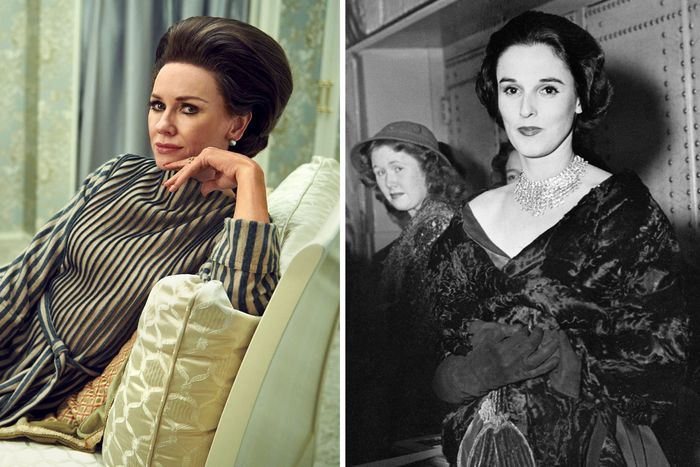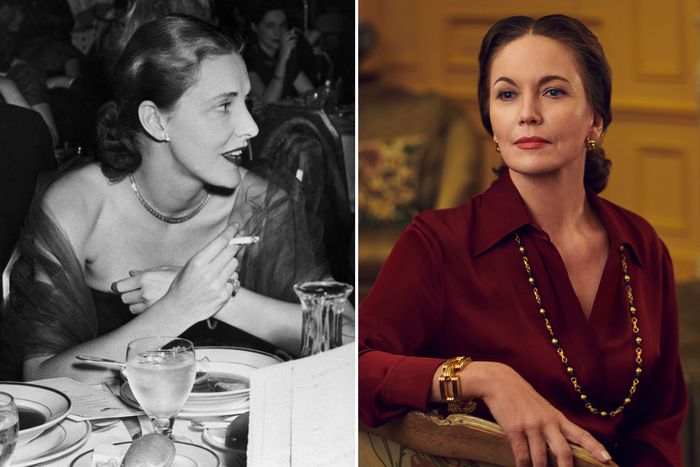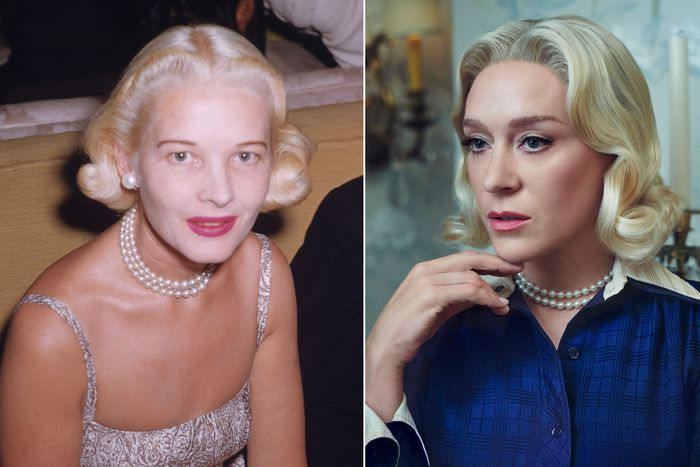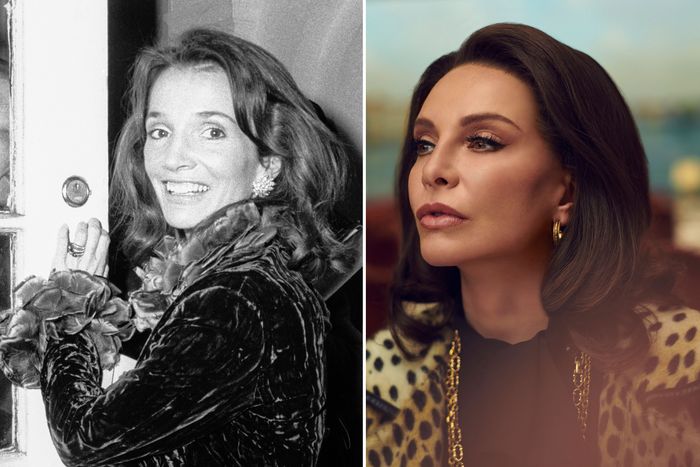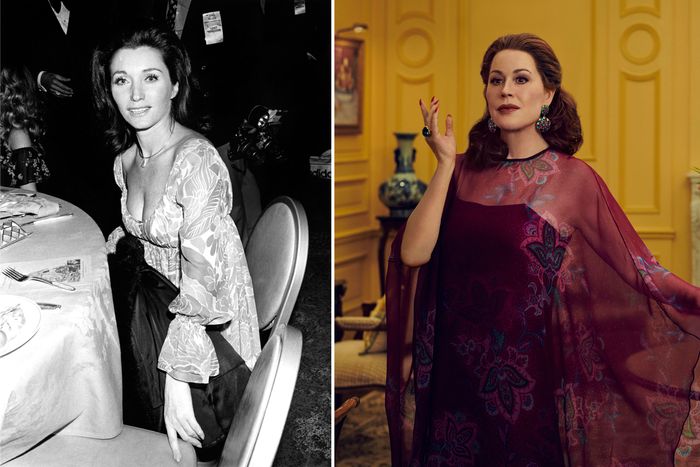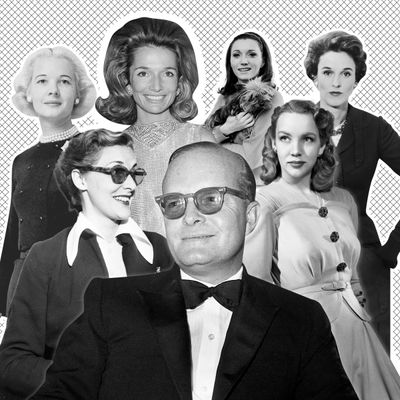
Decades before The Real Housewives would bring dysfunctional frenemy groups to our television screens, a group of glamorous, wealthy socialites dominated New York high society in the mid-20th century. Truman Capote, author of Breakfast at Tiffany’s and In Cold Blood, called them his “swans.” The second season of Ryan Murphy’s FX anthology, Feud: Capote vs. The Swans, chronicles their sumptuous and troubled lives at a time when Capote (played by Tom Hollander) began writing a new book that fictionalized their private lives, exposing their dark secrets to the scrutiny of the public. The show is based on Capote’s Women: A True Story of Love, Betrayal, and a Swan Song for an Era, the 2021 nonfiction account of these events written by biographer Laurence Leamer.
By the mid-1970s, Capote was at the height of his fame as an author, paraded around at the swans’ lavish dinner parties as gay entertainment, and a regular on late-night talk shows. Born and raised in a small town in Alabama, he was in many ways an outsider to this world — simultaneously fascinated and disturbed by high society. Under pressure to follow up on his previous successes and in the midst of a life-long battle with drug abuse and alcoholism, Capote began writing Answered Prayers, a loosely veiled tell-all that exposed the secret lives of the swans he surrounded himself with in New York. An excerpt was published in Esquire in 1975 and essentially excommunicated him from the New York social scene. Answered Prayers was never officially finished and was published posthumously in 1986.
So, who were these women? You might recognize some of them by their last names — many of them did have equally, if not more, famous husbands. But they were mid-century “It” girls who made history in their own right. The second season of Feud features each of the following women in Capote’s orbit, focusing on how quickly his flock left him to drown.
Babe Paley (played by Naomi Watts)
Barbara “Babe” Paley is central to this new season of Feud. She was the daughter of Harvey Cushing, a renowned neurosurgeon. After moving to New York City from Boston in 1938, Babe worked at Vogue as a fashion editor for two years and routinely showed up on best-dressed lists for her “flawless” taste. A few years before moving to New York, Babe was in a car accident that knocked her teeth out. Despite having to wear fake teeth and endure scars, some claim her beauty was elevated by cosmetic surgeries. Capote once remarked that Babe’s only flaw was her perfection.
She left Vogue when she married William S. Paley in 1940, her second husband and the chief executive responsible for building up CBS to one of the ‘big three’ television networks for its time. He also founded the Paley Center for Media, the museum in midtown Manhattan still open to the public today. He frequently had affairs with other women, some within Babe’s very own friend group. Capote weaponized these affairs in Answered Prayers, leading to his disownment as Babe’s confidante.
Slim Keith (played by Diane Lane)
A California-raised swan who immersed herself in Hollywood glamour and the jet-set lifestyle, Nancy “Slim” Keith was nicknamed “Big Mama” by Capote, according to her obituary in the New York Times. Slim was close friends with the writer Ernest Hemingway, the actress Lauren Bacall (whom she claims she “discovered”), and fellow swan Babe Paley. She was known for her witty and intelligent sensibility in addition to being a trailblazer of relaxed California style, often landing on the cover of Harper’s Bazaar and beating out the Duchess of Windsor for best dressed in 1946.
She had three marriages between 1941 and 1972: Scarface director Howard Hawks, Broadway producer Leland Hayward, and Kenneth Keith, the British Baron Keith of Castleacre. Her memoir, Slim: Memories of a Rich and Imperfect Life was published shortly after her death in 1990. After Capote wrote about her in his Esquire essay, she allegedly never spoke to him again.
C. Z. Guest (played by Chloë Sevigny)
Lucy Douglas “C. Z.” Guest was known, of course, for her beauty. But more surprisingly, she was a passionate gardener and horticulturist since her childhood in Boston. Her first book on the subject was illustrated by iconic photographer Cecil Beaton, one of many creative friends she surrounded herself with including Barbara Hutton, Diana Vreeland, and her children’s godparents, the Duke and Duchess of Windsor. Ernest Hemingway was best man at her wedding to polo player Winston Frederick Churchill Guest, first cousin of Winston Churchill, which took place at Hemingway’s house in Havana, Cuba.
Aside from her writing and horseback riding, she started various business endeavors, including designing a sportswear collection, cashmere sweaters, and garden tools. Appearing on the cover of Time in 1962, she was the epitome of understated elegance, “a cool vanilla lady,” according to Capote. Unlike Babe and Slim, C. Z. continued to speak to Capote following his Esquire essay and the group’s fallout.
Lee Radziwill (played by Calista Flockhart)
Lee Radziwill may be best known for living in the shadow of her sister, Jacqueline Kennedy Onassis, but she was ambitious in pursuing various creative pursuits throughout her life. Before befriending Capote, Lee was quite close to Jackie, traveling with her and spending time at the White House. She stayed by her side following President John F. Kennedy’s assassination, eventually helping her relocate to New York in the 1960s and facilitated her subsequent marriage to Aristotle Onassis, a close friend of Stanisław Albrecht Radziwiłł, the Polish aristocrat married to Lee at the time (designating her a princess, technically).
The sisters drifted apart later in the ’60s, which is when Lee met Capote and pursued short-lived ventures in acting, interior designing, and writing, none of which were particularly successful. Their fallout came soon after Capote arranged for a producer to cast her in a television play of Laura, an adaptation of the 1944 film. Lee’s performance was panned by critics. Variety simply stated: “She is just not an actress.” The final straw in their friendship was Lee’s refusal to testify in a libel suit that Capote lost against writer and rival Gore Vidal. Eventually, Lee reportedly let it slip to gossip columnist Liz Smith that she was actually quite homophobic.
Ann Woodward (played by Demi Moore)
Ann Woodward may be the most controversial swan in Capote’s cohort. The socialite, born in Kansas City, moved to New York in the late 1930s to pursue modeling and radio acting — she was referred to as “the most beautiful girl in radio.” She married William Woodward Jr. in 1943, a war veteran and heir to a bank’s fortune. He was shot to death by Ann in 1955 after she mistook him for a burglar. A grand jury cleared her of charges, but the case drew widespread attention. In 1975, Ann learned that Capote was planning to reignite public scrutiny on the case in his upcoming book and consumed a cyanide pill that led to her death.
Joanne Carson (played by Molly Ringwald)
Joanne Carson was somewhat on the outside of the swans’ inner circle, but held a friendship with Capote that she kept until his death in 1984. Joanne was raised in a convent in California, eventually becoming a model and stewardess for Pan American World Airways before meeting renowned television host Johnny Carson in 1960. Upon their divorce in 1972, she moved back to California where she worked as a television talk-show host herself. Capote met her in 1966 at a dinner party and they formed an unlikely bond; he spent months out of every year in her Sunset Boulevard house, eventually spending his last days in a writing room dedicated to him. Joanne, who lived until 2015, said she saw a “wounded child” in Capote, one she could identify with until the end.



